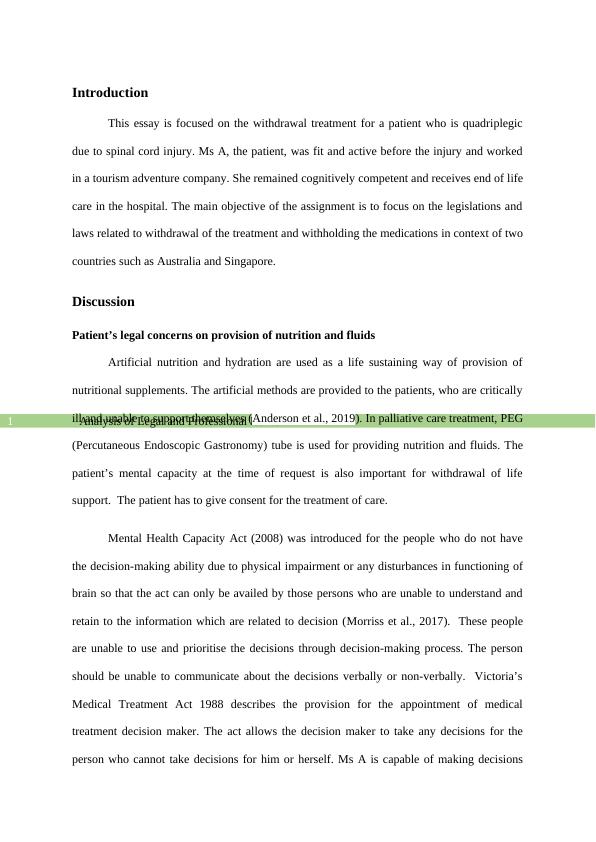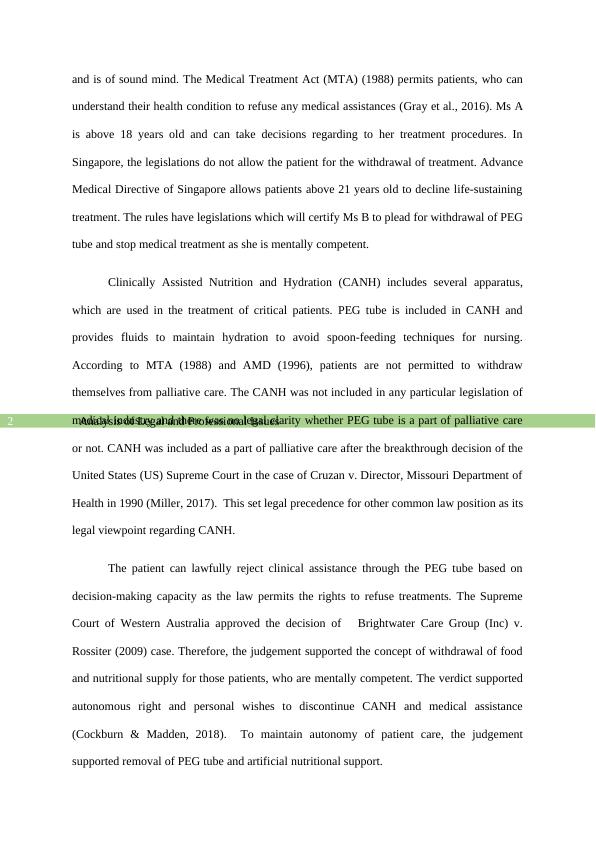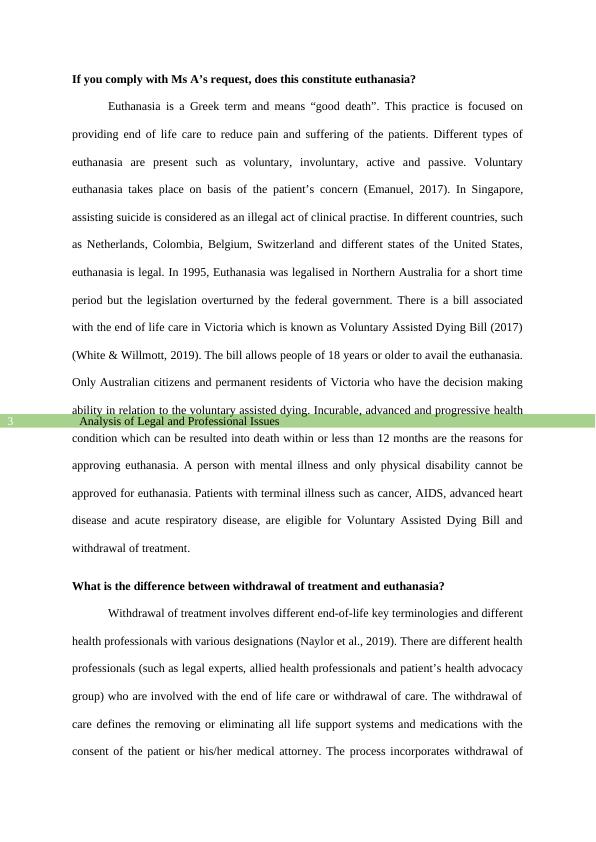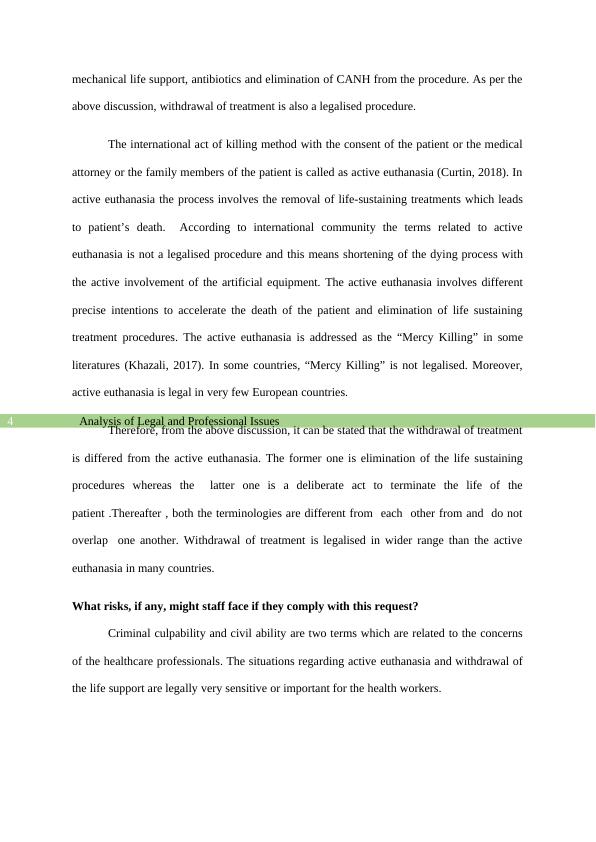Analysis of Legal and Professional Issues
Developing a code of conduct for nurses to establish requirements for professional and safe practice in Australia
11 Pages3321 Words27 Views
Added on 2022-09-05
Analysis of Legal and Professional Issues
Developing a code of conduct for nurses to establish requirements for professional and safe practice in Australia
Added on 2022-09-05
ShareRelated Documents
Running head: case study analysis of legal and professional issues
Analysis of Legal and Professional Issues
Name of the Student
Name of the University
Authors Note
Analysis of Legal and Professional Issues
Name of the Student
Name of the University
Authors Note

Analysis of Legal and Professional Issues1
Introduction
This essay is focused on the withdrawal treatment for a patient who is quadriplegic
due to spinal cord injury. Ms A, the patient, was fit and active before the injury and worked
in a tourism adventure company. She remained cognitively competent and receives end of life
care in the hospital. The main objective of the assignment is to focus on the legislations and
laws related to withdrawal of the treatment and withholding the medications in context of two
countries such as Australia and Singapore.
Discussion
Patient’s legal concerns on provision of nutrition and fluids
Artificial nutrition and hydration are used as a life sustaining way of provision of
nutritional supplements. The artificial methods are provided to the patients, who are critically
ill and unable to support themselves (Anderson et al., 2019). In palliative care treatment, PEG
(Percutaneous Endoscopic Gastronomy) tube is used for providing nutrition and fluids. The
patient’s mental capacity at the time of request is also important for withdrawal of life
support. The patient has to give consent for the treatment of care.
Mental Health Capacity Act (2008) was introduced for the people who do not have
the decision-making ability due to physical impairment or any disturbances in functioning of
brain so that the act can only be availed by those persons who are unable to understand and
retain to the information which are related to decision (Morriss et al., 2017). These people
are unable to use and prioritise the decisions through decision-making process. The person
should be unable to communicate about the decisions verbally or non-verbally. Victoria’s
Medical Treatment Act 1988 describes the provision for the appointment of medical
treatment decision maker. The act allows the decision maker to take any decisions for the
person who cannot take decisions for him or herself. Ms A is capable of making decisions
Introduction
This essay is focused on the withdrawal treatment for a patient who is quadriplegic
due to spinal cord injury. Ms A, the patient, was fit and active before the injury and worked
in a tourism adventure company. She remained cognitively competent and receives end of life
care in the hospital. The main objective of the assignment is to focus on the legislations and
laws related to withdrawal of the treatment and withholding the medications in context of two
countries such as Australia and Singapore.
Discussion
Patient’s legal concerns on provision of nutrition and fluids
Artificial nutrition and hydration are used as a life sustaining way of provision of
nutritional supplements. The artificial methods are provided to the patients, who are critically
ill and unable to support themselves (Anderson et al., 2019). In palliative care treatment, PEG
(Percutaneous Endoscopic Gastronomy) tube is used for providing nutrition and fluids. The
patient’s mental capacity at the time of request is also important for withdrawal of life
support. The patient has to give consent for the treatment of care.
Mental Health Capacity Act (2008) was introduced for the people who do not have
the decision-making ability due to physical impairment or any disturbances in functioning of
brain so that the act can only be availed by those persons who are unable to understand and
retain to the information which are related to decision (Morriss et al., 2017). These people
are unable to use and prioritise the decisions through decision-making process. The person
should be unable to communicate about the decisions verbally or non-verbally. Victoria’s
Medical Treatment Act 1988 describes the provision for the appointment of medical
treatment decision maker. The act allows the decision maker to take any decisions for the
person who cannot take decisions for him or herself. Ms A is capable of making decisions

Analysis of Legal and Professional Issues2
and is of sound mind. The Medical Treatment Act (MTA) (1988) permits patients, who can
understand their health condition to refuse any medical assistances (Gray et al., 2016). Ms A
is above 18 years old and can take decisions regarding to her treatment procedures. In
Singapore, the legislations do not allow the patient for the withdrawal of treatment. Advance
Medical Directive of Singapore allows patients above 21 years old to decline life-sustaining
treatment. The rules have legislations which will certify Ms B to plead for withdrawal of PEG
tube and stop medical treatment as she is mentally competent.
Clinically Assisted Nutrition and Hydration (CANH) includes several apparatus,
which are used in the treatment of critical patients. PEG tube is included in CANH and
provides fluids to maintain hydration to avoid spoon-feeding techniques for nursing.
According to MTA (1988) and AMD (1996), patients are not permitted to withdraw
themselves from palliative care. The CANH was not included in any particular legislation of
medical industry and there was no legal clarity whether PEG tube is a part of palliative care
or not. CANH was included as a part of palliative care after the breakthrough decision of the
United States (US) Supreme Court in the case of Cruzan v. Director, Missouri Department of
Health in 1990 (Miller, 2017). This set legal precedence for other common law position as its
legal viewpoint regarding CANH.
The patient can lawfully reject clinical assistance through the PEG tube based on
decision-making capacity as the law permits the rights to refuse treatments. The Supreme
Court of Western Australia approved the decision of Brightwater Care Group (Inc) v.
Rossiter (2009) case. Therefore, the judgement supported the concept of withdrawal of food
and nutritional supply for those patients, who are mentally competent. The verdict supported
autonomous right and personal wishes to discontinue CANH and medical assistance
(Cockburn & Madden, 2018). To maintain autonomy of patient care, the judgement
supported removal of PEG tube and artificial nutritional support.
and is of sound mind. The Medical Treatment Act (MTA) (1988) permits patients, who can
understand their health condition to refuse any medical assistances (Gray et al., 2016). Ms A
is above 18 years old and can take decisions regarding to her treatment procedures. In
Singapore, the legislations do not allow the patient for the withdrawal of treatment. Advance
Medical Directive of Singapore allows patients above 21 years old to decline life-sustaining
treatment. The rules have legislations which will certify Ms B to plead for withdrawal of PEG
tube and stop medical treatment as she is mentally competent.
Clinically Assisted Nutrition and Hydration (CANH) includes several apparatus,
which are used in the treatment of critical patients. PEG tube is included in CANH and
provides fluids to maintain hydration to avoid spoon-feeding techniques for nursing.
According to MTA (1988) and AMD (1996), patients are not permitted to withdraw
themselves from palliative care. The CANH was not included in any particular legislation of
medical industry and there was no legal clarity whether PEG tube is a part of palliative care
or not. CANH was included as a part of palliative care after the breakthrough decision of the
United States (US) Supreme Court in the case of Cruzan v. Director, Missouri Department of
Health in 1990 (Miller, 2017). This set legal precedence for other common law position as its
legal viewpoint regarding CANH.
The patient can lawfully reject clinical assistance through the PEG tube based on
decision-making capacity as the law permits the rights to refuse treatments. The Supreme
Court of Western Australia approved the decision of Brightwater Care Group (Inc) v.
Rossiter (2009) case. Therefore, the judgement supported the concept of withdrawal of food
and nutritional supply for those patients, who are mentally competent. The verdict supported
autonomous right and personal wishes to discontinue CANH and medical assistance
(Cockburn & Madden, 2018). To maintain autonomy of patient care, the judgement
supported removal of PEG tube and artificial nutritional support.

Analysis of Legal and Professional Issues3
If you comply with Ms A’s request, does this constitute euthanasia?
Euthanasia is a Greek term and means “good death”. This practice is focused on
providing end of life care to reduce pain and suffering of the patients. Different types of
euthanasia are present such as voluntary, involuntary, active and passive. Voluntary
euthanasia takes place on basis of the patient’s concern (Emanuel, 2017). In Singapore,
assisting suicide is considered as an illegal act of clinical practise. In different countries, such
as Netherlands, Colombia, Belgium, Switzerland and different states of the United States,
euthanasia is legal. In 1995, Euthanasia was legalised in Northern Australia for a short time
period but the legislation overturned by the federal government. There is a bill associated
with the end of life care in Victoria which is known as Voluntary Assisted Dying Bill (2017)
(White & Willmott, 2019). The bill allows people of 18 years or older to avail the euthanasia.
Only Australian citizens and permanent residents of Victoria who have the decision making
ability in relation to the voluntary assisted dying. Incurable, advanced and progressive health
condition which can be resulted into death within or less than 12 months are the reasons for
approving euthanasia. A person with mental illness and only physical disability cannot be
approved for euthanasia. Patients with terminal illness such as cancer, AIDS, advanced heart
disease and acute respiratory disease, are eligible for Voluntary Assisted Dying Bill and
withdrawal of treatment.
What is the difference between withdrawal of treatment and euthanasia?
Withdrawal of treatment involves different end-of-life key terminologies and different
health professionals with various designations (Naylor et al., 2019). There are different health
professionals (such as legal experts, allied health professionals and patient’s health advocacy
group) who are involved with the end of life care or withdrawal of care. The withdrawal of
care defines the removing or eliminating all life support systems and medications with the
consent of the patient or his/her medical attorney. The process incorporates withdrawal of
If you comply with Ms A’s request, does this constitute euthanasia?
Euthanasia is a Greek term and means “good death”. This practice is focused on
providing end of life care to reduce pain and suffering of the patients. Different types of
euthanasia are present such as voluntary, involuntary, active and passive. Voluntary
euthanasia takes place on basis of the patient’s concern (Emanuel, 2017). In Singapore,
assisting suicide is considered as an illegal act of clinical practise. In different countries, such
as Netherlands, Colombia, Belgium, Switzerland and different states of the United States,
euthanasia is legal. In 1995, Euthanasia was legalised in Northern Australia for a short time
period but the legislation overturned by the federal government. There is a bill associated
with the end of life care in Victoria which is known as Voluntary Assisted Dying Bill (2017)
(White & Willmott, 2019). The bill allows people of 18 years or older to avail the euthanasia.
Only Australian citizens and permanent residents of Victoria who have the decision making
ability in relation to the voluntary assisted dying. Incurable, advanced and progressive health
condition which can be resulted into death within or less than 12 months are the reasons for
approving euthanasia. A person with mental illness and only physical disability cannot be
approved for euthanasia. Patients with terminal illness such as cancer, AIDS, advanced heart
disease and acute respiratory disease, are eligible for Voluntary Assisted Dying Bill and
withdrawal of treatment.
What is the difference between withdrawal of treatment and euthanasia?
Withdrawal of treatment involves different end-of-life key terminologies and different
health professionals with various designations (Naylor et al., 2019). There are different health
professionals (such as legal experts, allied health professionals and patient’s health advocacy
group) who are involved with the end of life care or withdrawal of care. The withdrawal of
care defines the removing or eliminating all life support systems and medications with the
consent of the patient or his/her medical attorney. The process incorporates withdrawal of

End of preview
Want to access all the pages? Upload your documents or become a member.
Related Documents
Australian Government Departments of Healthlg...
|13
|3369
|31
Case Act of Medical Treatment Act, 1988 : Reportlg...
|7
|1307
|35
Case Study Analysis on Legal and Professional Issuelg...
|12
|3563
|19
Legal and Ethical Responsibilities - Case Studylg...
|8
|1722
|36
Argument and Advanced Care Planning and Directives Essay 2022lg...
|7
|1755
|19
Group Work Research Project 2022lg...
|5
|1016
|13
